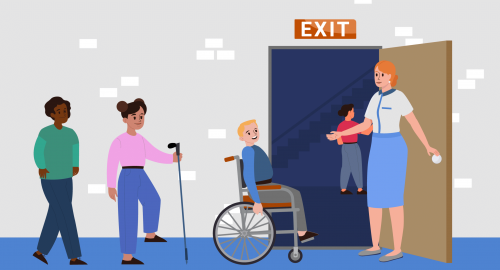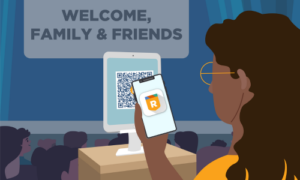By Michele Gay, Co-Founder and Executive Director of Safe and Sound Schools
Listen to this blog
4 minutes
When planning your emergency response procedures, it’s important to take your most vulnerable students, staff, and visitors into consideration. An inclusive safety response includes supporting those with unique needs due to disabilities, those who need communication support—including those who speak a language other than English—as well as those who have mental health considerations, such as anxiety or trauma.
“School safety is complex. It’s big, in terms of solutions and programs and approaches and ideas. It’s a challenge to meet the needs of typical students, let alone the very special and specific needs of so many of our students. Protecting every student is what the Especially Safe program is about.” Michele Gay, Co-Founder of Safe and Sound Schools
Safe and Sound Schools created their newest program, Especially Safe, to help safety planning teams address the safety and security needs of all members of the community.
Why Especially Safe?
For Michele Gay, finding information about her daughter Josephine, who was nonverbal, autistic, and had both gross motor and fine motor challenges, on December 14, 2012, proved to be quite difficult. Quickly able to ascertain her older two daughters were safe, Michele struggled to locate her youngest or the trusted adults responsible for her. Ultimately, she learned the worst possible news: that Josephine, along with 19 of her classmates and 6 educators, had been killed.
Where the emergency plans in place had served her older daughters well in keeping them safe, the plan had failed Josephine. Moving through the events that day, questions swirled in Michele’s mind:
What about students like Josephine—those who cannot speak for themselves, who might have difficulty quickly moving, or evacuating?
Protecting every school and every student every day means keeping in mind those children who are especially special. But meeting the needs of typical students when it comes to school safety is a complex and ever-growing process.
So, how do we keep our especially special kids safe? How do we support our school communities in doing that?
What does Especially Safe include?
The Especially Safe program includes an Inclusive Safety Planning (ISP) guide with the following six steps:
- Gather your team
- Identify special needs
- Build individual teams
- Create an ISP
- Share the plan
- Review and adjust
A multidisciplinary team is key—a diverse team provides a wider range of perspectives, backgrounds, and areas of expertise. Safety teams should also consult with the experts when it comes to student needs and abilities—and that includes the student and their parents/guardians as well as the student’s special education teachers and paraprofessionals.
You can download the guides and resources from Safe and Sounds Schools here.
The TEAMS Framework
As part of the ISP guide, Safe and Sound Schools provides districts with the TEAMS Framework. The five categories included in the framework—and which give the guide its acronym—are:
- Transportation and Mobility
- Emotional, Mental, and Behavioral Health
- Auxiliary Communication
- Medical Health
- Security and Supervision
Let’s take a closer look at each of these five categories.
1. Transportation and mobility
It’s important to make sure your evacuation or lockdown plan considers the physical restrictions of the students, staff, or visitors who may be present during a crisis. Consider the following questions when refining your emergency response procedures:
- Is your planned evacuation route accessible to those who use a wheelchair, crutches, or have an impaired gait?
- What assistance will they require to navigate that route and any potential obstacles that might occur, such as in the event of a fire or natural disaster?
2. Emotional, mental, behavioral health
There are mental, emotional, and behavioral challenges that lockdowns, evacuations, and other emergency responses present. It is important to take these into consideration and not initiate surprise lockdowns. For many students, the drills themselves generate anxiety and trauma-responses. Announce drills and use trauma-informed instruction when teaching students how to respond appropriately—the guide on trauma-informed approaches by Substance Abuse and Mental Health Services Administration (SAMHSA) can be found here—and with special needs students, it’s best to teach those behaviors first, then practice them in drills.
With the support of their special education teachers, students with disabilities will benefit from having additional time to learn and discuss the concepts, language and symbols, and expected behaviors during emergencies. This additional time provides another opportunity to review the physical demands the planned drill may have upon each student—and to verify those demands do not exceed the capabilities of the student.
3. Auxiliary communication
Consider any auxiliary communication needs that require addressing—including those for people who speak a language other than English. Teach students how to communicate with emergency personnel and develop a plan for providing any communication tools they may need. For example, if a nonverbal student carries a planner, including communication cards—that they practice with in advance—inside it can allow them to communicate with emergency responders.
4. Medical health
Plans need to include students with medical health needs—those with allergic reactions, asthma, diabetes, or seizures, for example. School personnel will need to have access to the necessary medical supplies and equipment during emergencies.
5. Security and supervision
Scared, anxious students—especially those with behavioral, emotional, or mental disabilities or challenges—are more likely to struggle with remaining quiet or stationary when faced with the physical, sensory, and emotional challenges an evacuation or lockdown creates. To maintain accountability, students who may struggle to remain quiet or who may elope (run away) may require additional security and supervision during a crisis.
After the crisis
Inclusive safety planning doesn’t end with the crisis. Including support such as counseling services and mental health professionals following a crisis is important for all students and staff, but especially so for those with disabilities.
“Supporting the emotional, mental, and behavioral health of your students with disabilities includes providing designated quiet spaces or separate locations during lockdowns or reunification. Help them remain still and quiet with comfort items—and train staff to support individuals before, during, and after emergency practice and crises.” Michele Gay, Co-founder of Safe and Sound Schools
Have a plan in place for monitoring and identifying the low-level concerns that suggest a student may be struggling with trauma so you can more quickly connect them with the services they need.
For more information on how you can better support your students’ mental and emotional health and wellbeing, schedule a demonstration of StudentSafe.
Related Resources
Guide to K-12 Student Wellbeing
Strategies to Recognize, Document, and Support Students in Distress
Listen to this blog
4 minutes
Safe and Sound Schools
Founded by Michele Gay, mother of Josephine Grace Gay, and Alissa Parker, mother of Emilie Parker, Safe and Sound Schools is a national nonprofit safety advocacy and resource center that provides research-based tools and support for crisis-prevention, response, and recovery. Safe and Sound Schools is committed to protecting every school and every student, every day.








